HealthHero Group: Overview of UK Legal System and its Implications
VerifiedAdded on 2022/04/06
|25
|7336
|28
Report
AI Summary
This report provides an overview of the UK legal system, focusing on its relevance to HealthHero Group Limited, a healthcare platform. It begins with an introduction to HealthHero, its establishment, and business operations. The report then delves into the UK legal system, differentiating between common law and statutory law, and outlining the court system's structure. It explores the functions and purposes of law, distinguishing between criminal and civil law. The report further analyzes the sources of law, including common law, equity, delegated legislation, customs, conventions, Acts of Parliament, European Union law, and the European Convention on Human Rights. The analysis includes examples and case studies to illustrate the application of legal principles. The report aims to provide a comprehensive understanding of the legal framework within which HealthHero operates and offers recommendations for legal compliance and business development.
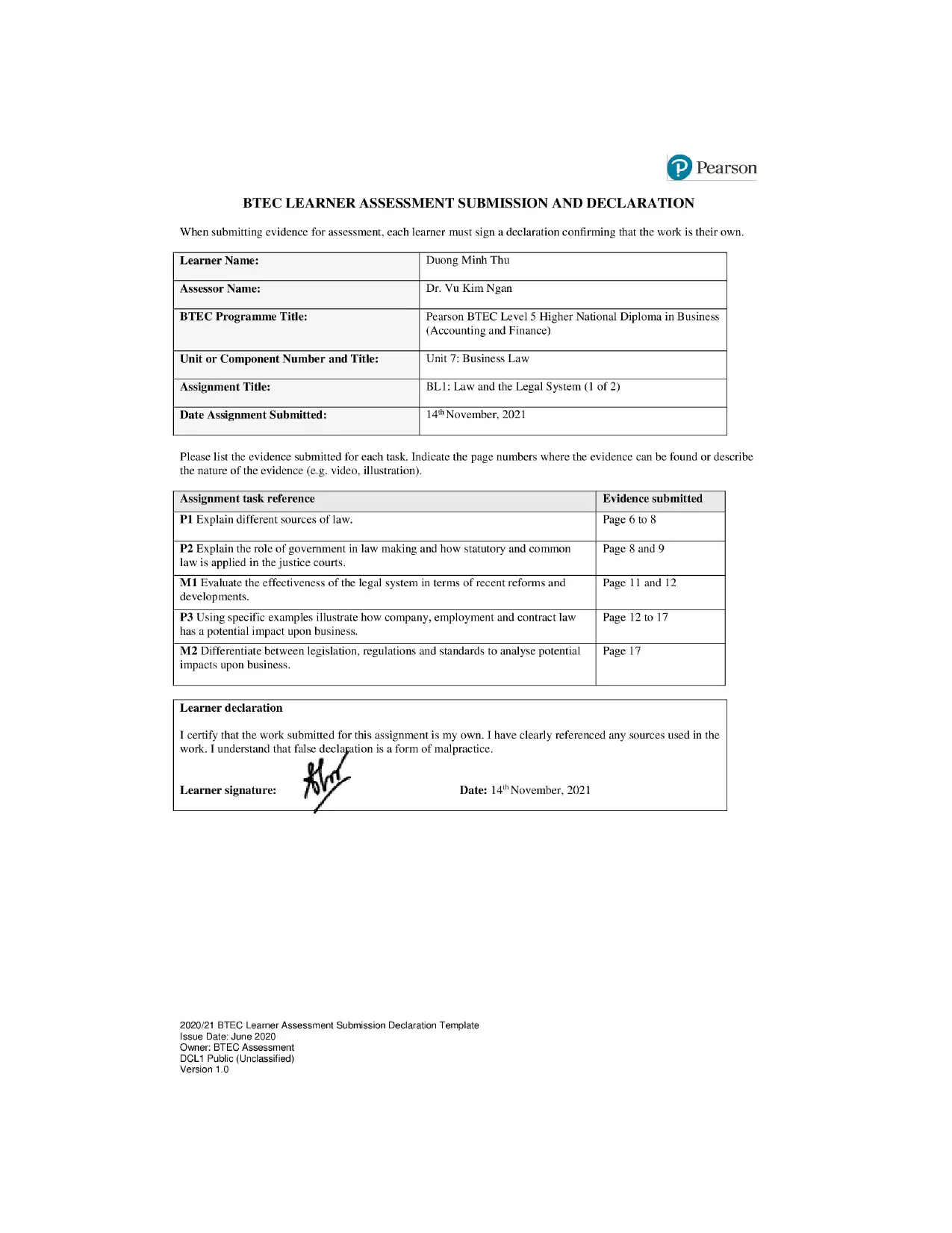
Paraphrase This Document
Need a fresh take? Get an instant paraphrase of this document with our AI Paraphraser
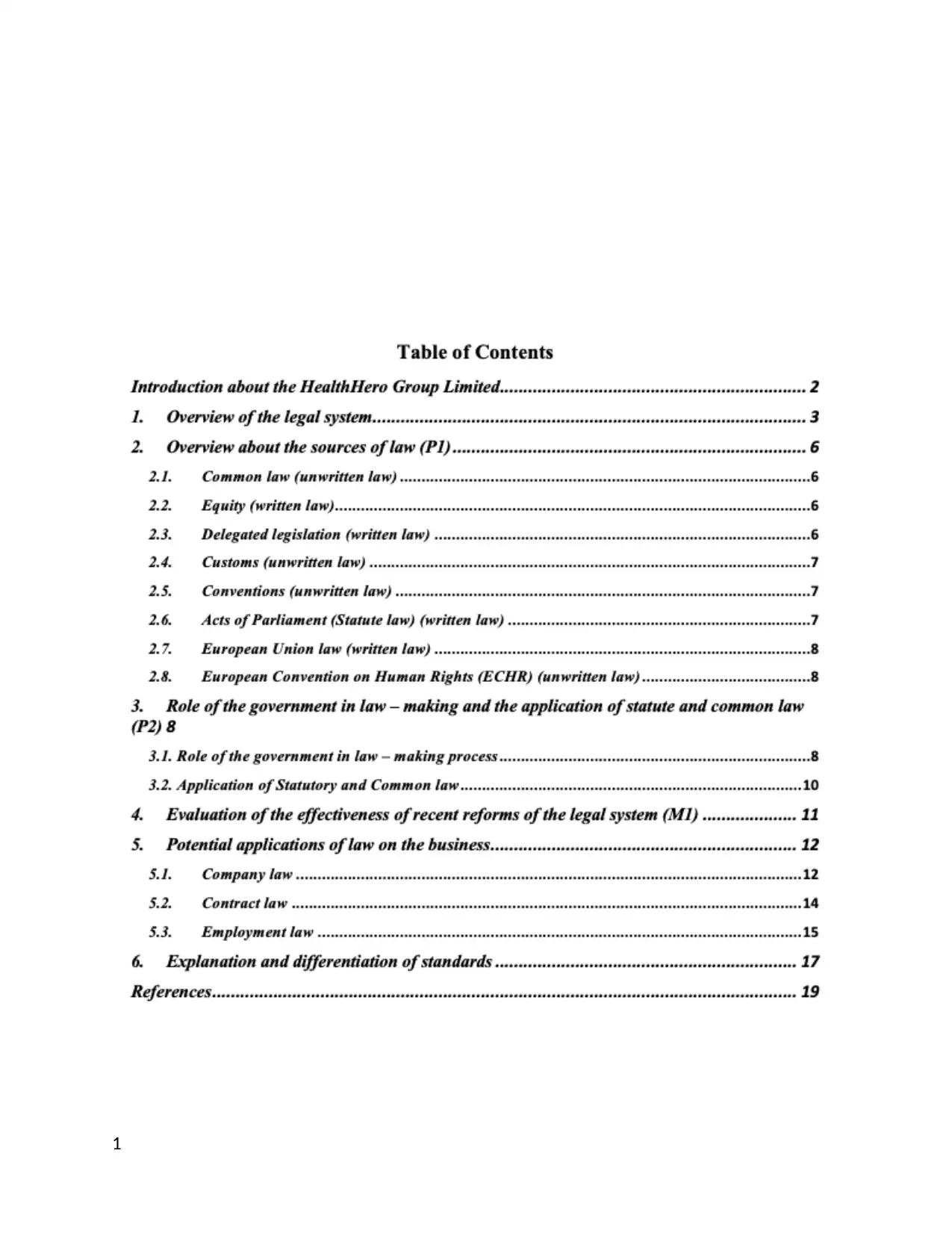
1
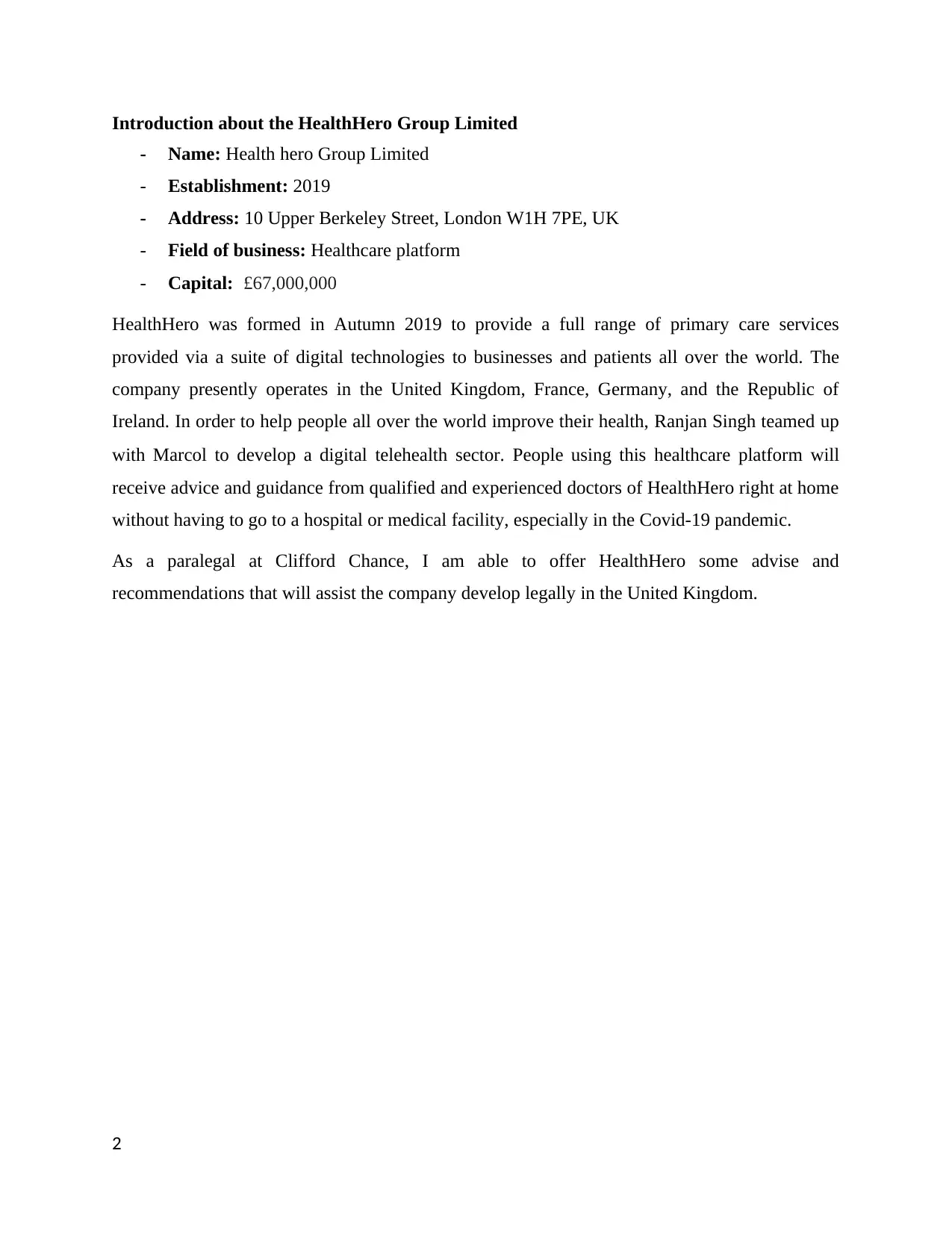
Introduction about the HealthHero Group Limited
- Name: Health hero Group Limited
- Establishment: 2019
- Address: 10 Upper Berkeley Street, London W1H 7PE, UK
- Field of business: Healthcare platform
- Capital: £67,000,000
HealthHero was formed in Autumn 2019 to provide a full range of primary care services
provided via a suite of digital technologies to businesses and patients all over the world. The
company presently operates in the United Kingdom, France, Germany, and the Republic of
Ireland. In order to help people all over the world improve their health, Ranjan Singh teamed up
with Marcol to develop a digital telehealth sector. People using this healthcare platform will
receive advice and guidance from qualified and experienced doctors of HealthHero right at home
without having to go to a hospital or medical facility, especially in the Covid-19 pandemic.
As a paralegal at Clifford Chance, I am able to offer HealthHero some advise and
recommendations that will assist the company develop legally in the United Kingdom.
2
- Name: Health hero Group Limited
- Establishment: 2019
- Address: 10 Upper Berkeley Street, London W1H 7PE, UK
- Field of business: Healthcare platform
- Capital: £67,000,000
HealthHero was formed in Autumn 2019 to provide a full range of primary care services
provided via a suite of digital technologies to businesses and patients all over the world. The
company presently operates in the United Kingdom, France, Germany, and the Republic of
Ireland. In order to help people all over the world improve their health, Ranjan Singh teamed up
with Marcol to develop a digital telehealth sector. People using this healthcare platform will
receive advice and guidance from qualified and experienced doctors of HealthHero right at home
without having to go to a hospital or medical facility, especially in the Covid-19 pandemic.
As a paralegal at Clifford Chance, I am able to offer HealthHero some advise and
recommendations that will assist the company develop legally in the United Kingdom.
2
⊘ This is a preview!⊘
Do you want full access?
Subscribe today to unlock all pages.

Trusted by 1+ million students worldwide
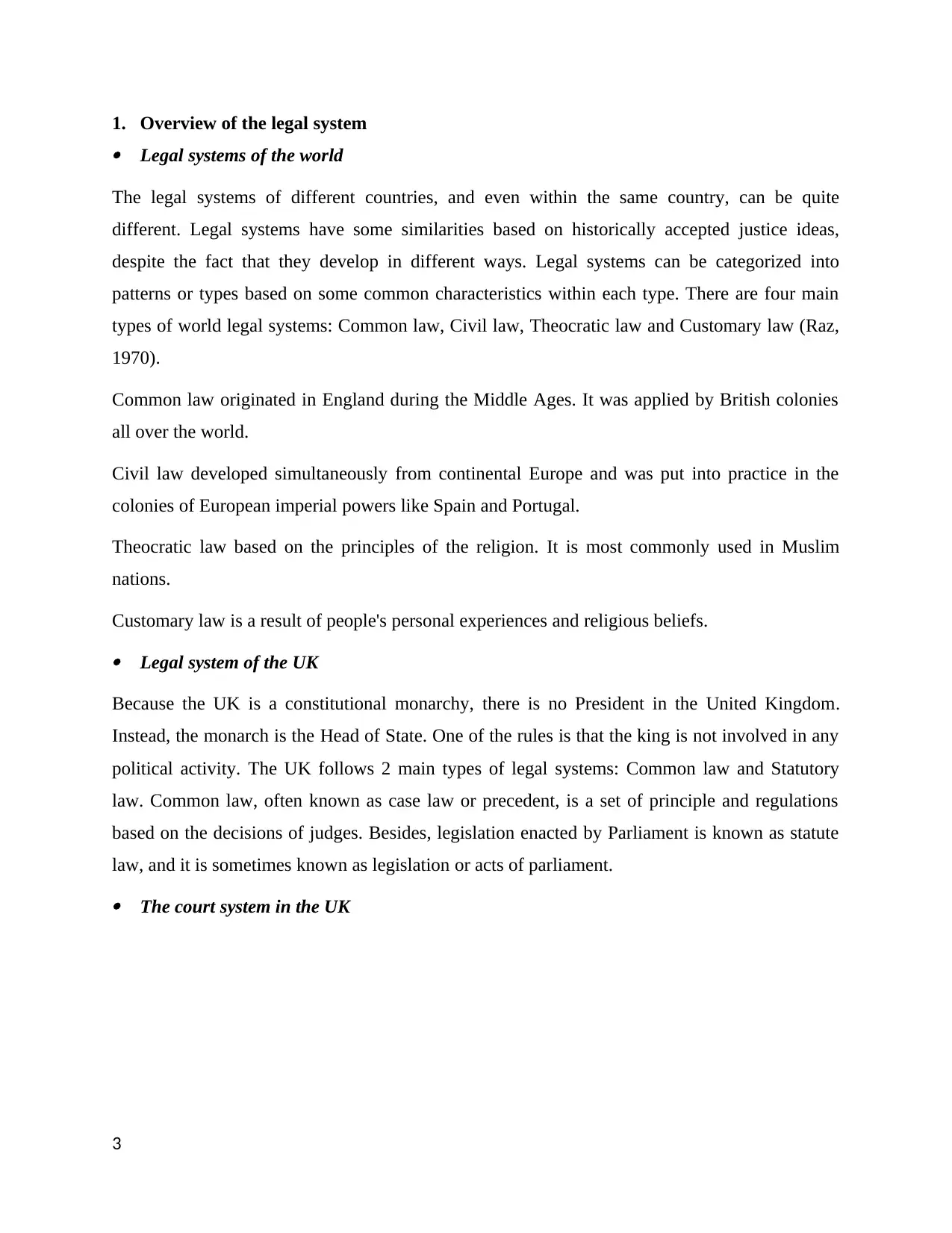
1. Overview of the legal system Legal systems of the world
The legal systems of different countries, and even within the same country, can be quite
different. Legal systems have some similarities based on historically accepted justice ideas,
despite the fact that they develop in different ways. Legal systems can be categorized into
patterns or types based on some common characteristics within each type. There are four main
types of world legal systems: Common law, Civil law, Theocratic law and Customary law (Raz,
1970).
Common law originated in England during the Middle Ages. It was applied by British colonies
all over the world.
Civil law developed simultaneously from continental Europe and was put into practice in the
colonies of European imperial powers like Spain and Portugal.
Theocratic law based on the principles of the religion. It is most commonly used in Muslim
nations.
Customary law is a result of people's personal experiences and religious beliefs.
Legal system of the UK
Because the UK is a constitutional monarchy, there is no President in the United Kingdom.
Instead, the monarch is the Head of State. One of the rules is that the king is not involved in any
political activity. The UK follows 2 main types of legal systems: Common law and Statutory
law. Common law, often known as case law or precedent, is a set of principle and regulations
based on the decisions of judges. Besides, legislation enacted by Parliament is known as statute
law, and it is sometimes known as legislation or acts of parliament.
The court system in the UK
3
The legal systems of different countries, and even within the same country, can be quite
different. Legal systems have some similarities based on historically accepted justice ideas,
despite the fact that they develop in different ways. Legal systems can be categorized into
patterns or types based on some common characteristics within each type. There are four main
types of world legal systems: Common law, Civil law, Theocratic law and Customary law (Raz,
1970).
Common law originated in England during the Middle Ages. It was applied by British colonies
all over the world.
Civil law developed simultaneously from continental Europe and was put into practice in the
colonies of European imperial powers like Spain and Portugal.
Theocratic law based on the principles of the religion. It is most commonly used in Muslim
nations.
Customary law is a result of people's personal experiences and religious beliefs.
Legal system of the UK
Because the UK is a constitutional monarchy, there is no President in the United Kingdom.
Instead, the monarch is the Head of State. One of the rules is that the king is not involved in any
political activity. The UK follows 2 main types of legal systems: Common law and Statutory
law. Common law, often known as case law or precedent, is a set of principle and regulations
based on the decisions of judges. Besides, legislation enacted by Parliament is known as statute
law, and it is sometimes known as legislation or acts of parliament.
The court system in the UK
3
Paraphrase This Document
Need a fresh take? Get an instant paraphrase of this document with our AI Paraphraser
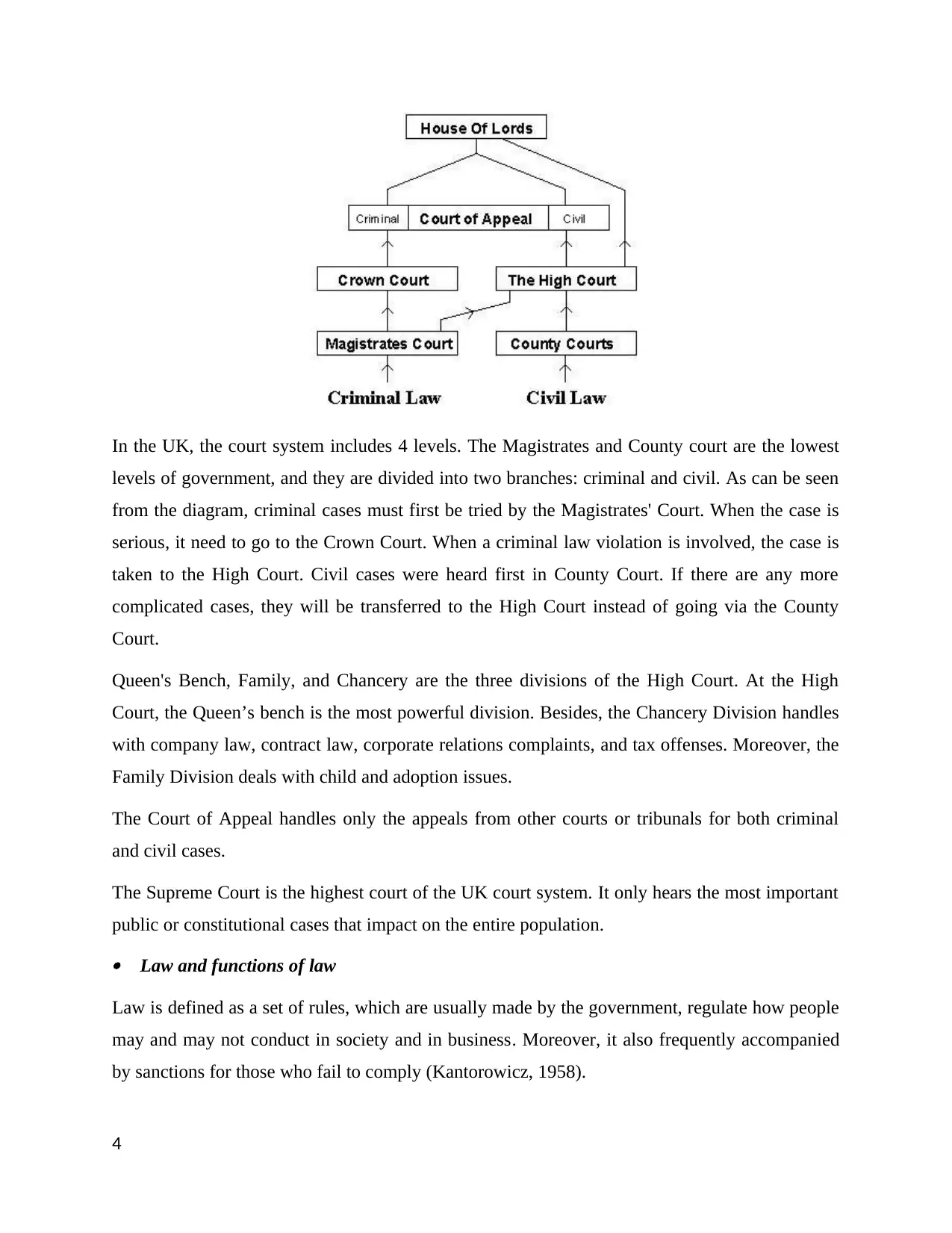
In the UK, the court system includes 4 levels. The Magistrates and County court are the lowest
levels of government, and they are divided into two branches: criminal and civil. As can be seen
from the diagram, criminal cases must first be tried by the Magistrates' Court. When the case is
serious, it need to go to the Crown Court. When a criminal law violation is involved, the case is
taken to the High Court. Civil cases were heard first in County Court. If there are any more
complicated cases, they will be transferred to the High Court instead of going via the County
Court.
Queen's Bench, Family, and Chancery are the three divisions of the High Court. At the High
Court, the Queen’s bench is the most powerful division. Besides, the Chancery Division handles
with company law, contract law, corporate relations complaints, and tax offenses. Moreover, the
Family Division deals with child and adoption issues.
The Court of Appeal handles only the appeals from other courts or tribunals for both criminal
and civil cases.
The Supreme Court is the highest court of the UK court system. It only hears the most important
public or constitutional cases that impact on the entire population.
Law and functions of law
Law is defined as a set of rules, which are usually made by the government, regulate how people
may and may not conduct in society and in business. Moreover, it also frequently accompanied
by sanctions for those who fail to comply (Kantorowicz, 1958).
4
levels of government, and they are divided into two branches: criminal and civil. As can be seen
from the diagram, criminal cases must first be tried by the Magistrates' Court. When the case is
serious, it need to go to the Crown Court. When a criminal law violation is involved, the case is
taken to the High Court. Civil cases were heard first in County Court. If there are any more
complicated cases, they will be transferred to the High Court instead of going via the County
Court.
Queen's Bench, Family, and Chancery are the three divisions of the High Court. At the High
Court, the Queen’s bench is the most powerful division. Besides, the Chancery Division handles
with company law, contract law, corporate relations complaints, and tax offenses. Moreover, the
Family Division deals with child and adoption issues.
The Court of Appeal handles only the appeals from other courts or tribunals for both criminal
and civil cases.
The Supreme Court is the highest court of the UK court system. It only hears the most important
public or constitutional cases that impact on the entire population.
Law and functions of law
Law is defined as a set of rules, which are usually made by the government, regulate how people
may and may not conduct in society and in business. Moreover, it also frequently accompanied
by sanctions for those who fail to comply (Kantorowicz, 1958).
4
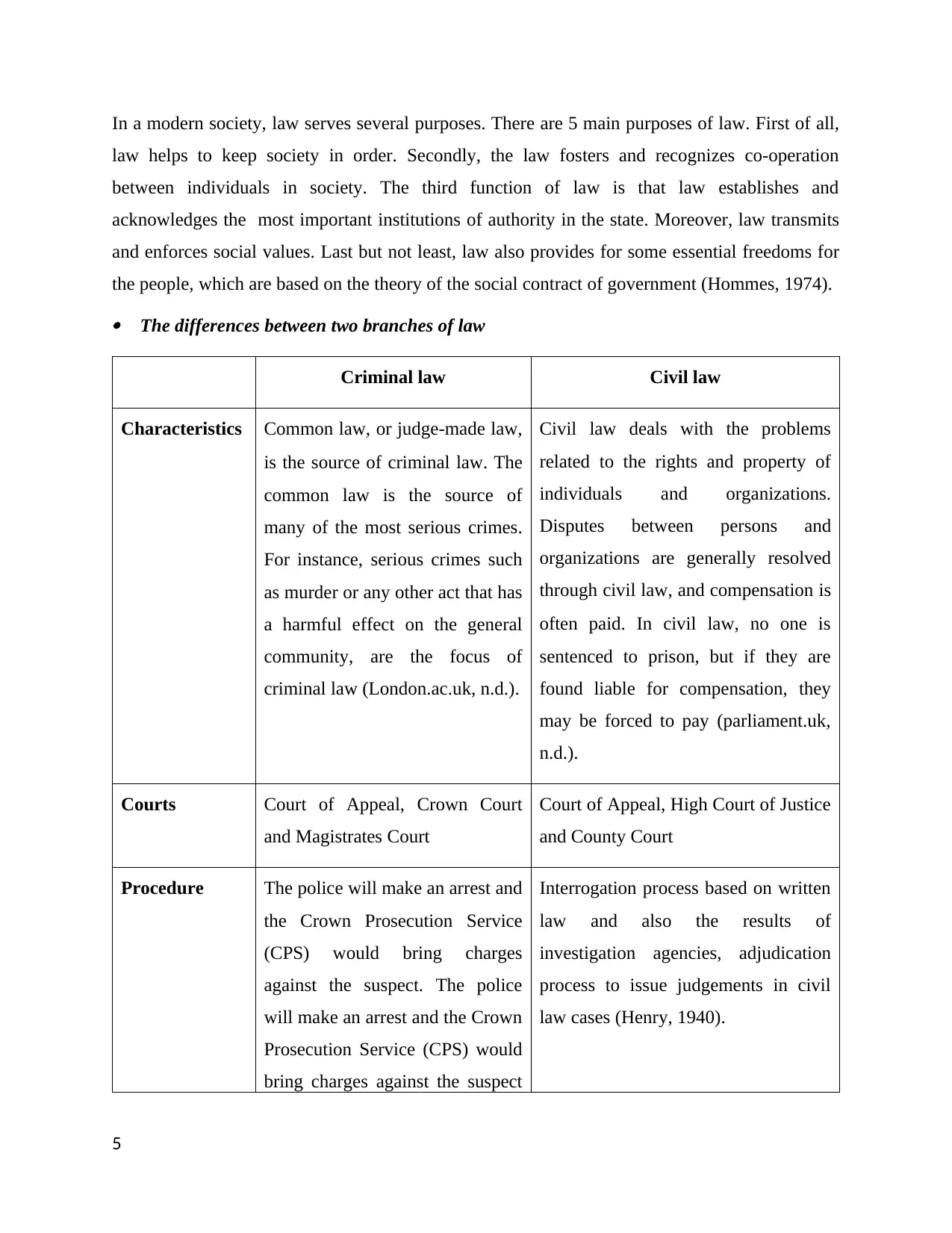
In a modern society, law serves several purposes. There are 5 main purposes of law. First of all,
law helps to keep society in order. Secondly, the law fosters and recognizes co-operation
between individuals in society. The third function of law is that law establishes and
acknowledges the most important institutions of authority in the state. Moreover, law transmits
and enforces social values. Last but not least, law also provides for some essential freedoms for
the people, which are based on the theory of the social contract of government (Hommes, 1974).
The differences between two branches of law
Criminal law Civil law
Characteristics Common law, or judge-made law,
is the source of criminal law. The
common law is the source of
many of the most serious crimes.
For instance, serious crimes such
as murder or any other act that has
a harmful effect on the general
community, are the focus of
criminal law (London.ac.uk, n.d.).
Civil law deals with the problems
related to the rights and property of
individuals and organizations.
Disputes between persons and
organizations are generally resolved
through civil law, and compensation is
often paid. In civil law, no one is
sentenced to prison, but if they are
found liable for compensation, they
may be forced to pay (parliament.uk,
n.d.).
Courts Court of Appeal, Crown Court
and Magistrates Court
Court of Appeal, High Court of Justice
and County Court
Procedure The police will make an arrest and
the Crown Prosecution Service
(CPS) would bring charges
against the suspect. The police
will make an arrest and the Crown
Prosecution Service (CPS) would
bring charges against the suspect
Interrogation process based on written
law and also the results of
investigation agencies, adjudication
process to issue judgements in civil
law cases (Henry, 1940).
5
law helps to keep society in order. Secondly, the law fosters and recognizes co-operation
between individuals in society. The third function of law is that law establishes and
acknowledges the most important institutions of authority in the state. Moreover, law transmits
and enforces social values. Last but not least, law also provides for some essential freedoms for
the people, which are based on the theory of the social contract of government (Hommes, 1974).
The differences between two branches of law
Criminal law Civil law
Characteristics Common law, or judge-made law,
is the source of criminal law. The
common law is the source of
many of the most serious crimes.
For instance, serious crimes such
as murder or any other act that has
a harmful effect on the general
community, are the focus of
criminal law (London.ac.uk, n.d.).
Civil law deals with the problems
related to the rights and property of
individuals and organizations.
Disputes between persons and
organizations are generally resolved
through civil law, and compensation is
often paid. In civil law, no one is
sentenced to prison, but if they are
found liable for compensation, they
may be forced to pay (parliament.uk,
n.d.).
Courts Court of Appeal, Crown Court
and Magistrates Court
Court of Appeal, High Court of Justice
and County Court
Procedure The police will make an arrest and
the Crown Prosecution Service
(CPS) would bring charges
against the suspect. The police
will make an arrest and the Crown
Prosecution Service (CPS) would
bring charges against the suspect
Interrogation process based on written
law and also the results of
investigation agencies, adjudication
process to issue judgements in civil
law cases (Henry, 1940).
5
⊘ This is a preview!⊘
Do you want full access?
Subscribe today to unlock all pages.

Trusted by 1+ million students worldwide
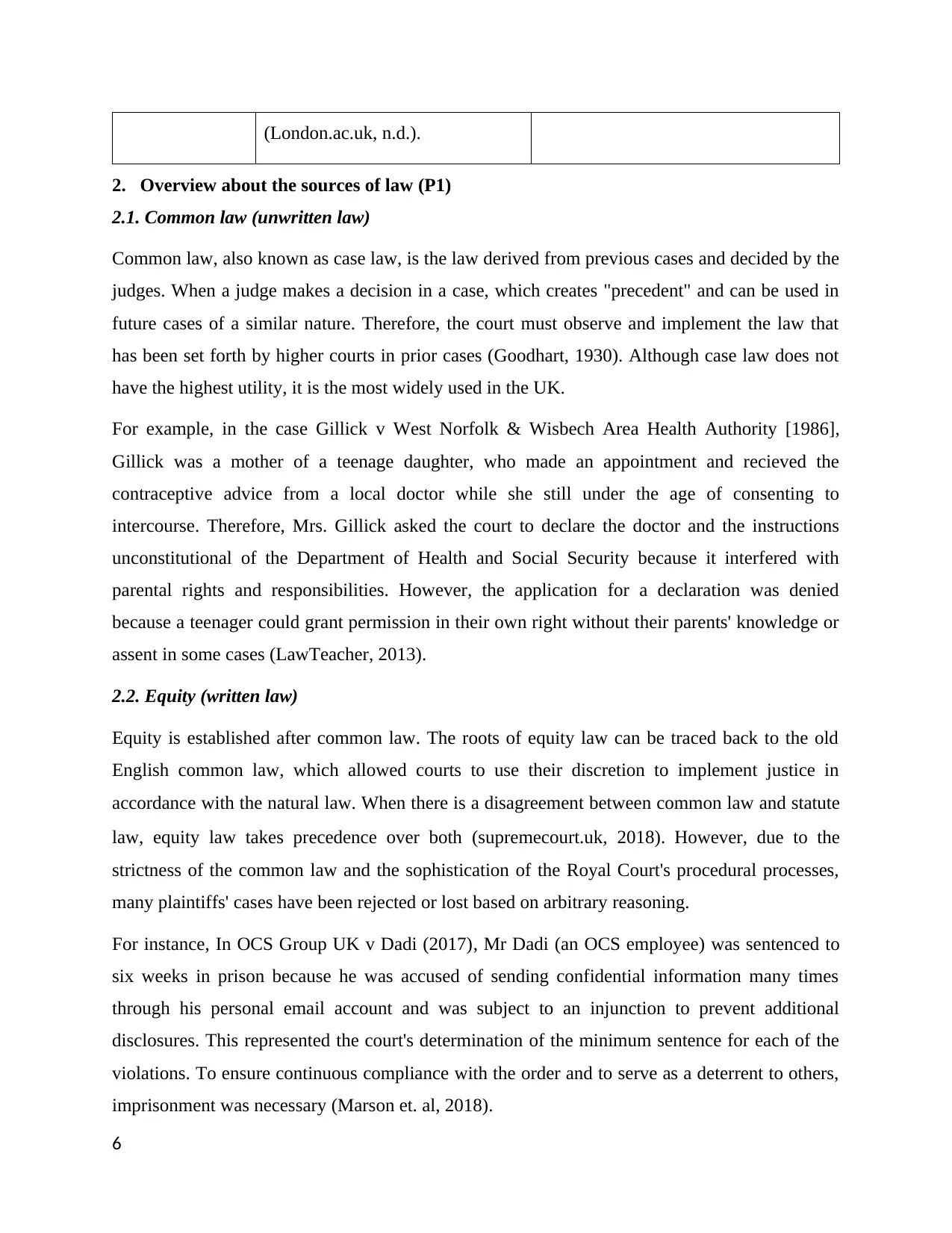
(London.ac.uk, n.d.).
2. Overview about the sources of law (P1)
2.1. Common law (unwritten law)
Common law, also known as case law, is the law derived from previous cases and decided by the
judges. When a judge makes a decision in a case, which creates "precedent" and can be used in
future cases of a similar nature. Therefore, the court must observe and implement the law that
has been set forth by higher courts in prior cases (Goodhart, 1930). Although case law does not
have the highest utility, it is the most widely used in the UK.
For example, in the case Gillick v West Norfolk & Wisbech Area Health Authority [1986],
Gillick was a mother of a teenage daughter, who made an appointment and recieved the
contraceptive advice from a local doctor while she still under the age of consenting to
intercourse. Therefore, Mrs. Gillick asked the court to declare the doctor and the instructions
unconstitutional of the Department of Health and Social Security because it interfered with
parental rights and responsibilities. However, the application for a declaration was denied
because a teenager could grant permission in their own right without their parents' knowledge or
assent in some cases (LawTeacher, 2013).
2.2. Equity (written law)
Equity is established after common law. The roots of equity law can be traced back to the old
English common law, which allowed courts to use their discretion to implement justice in
accordance with the natural law. When there is a disagreement between common law and statute
law, equity law takes precedence over both (supremecourt.uk, 2018). However, due to the
strictness of the common law and the sophistication of the Royal Court's procedural processes,
many plaintiffs' cases have been rejected or lost based on arbitrary reasoning.
For instance, In OCS Group UK v Dadi (2017), Mr Dadi (an OCS employee) was sentenced to
six weeks in prison because he was accused of sending confidential information many times
through his personal email account and was subject to an injunction to prevent additional
disclosures. This represented the court's determination of the minimum sentence for each of the
violations. To ensure continuous compliance with the order and to serve as a deterrent to others,
imprisonment was necessary (Marson et. al, 2018).
6
2. Overview about the sources of law (P1)
2.1. Common law (unwritten law)
Common law, also known as case law, is the law derived from previous cases and decided by the
judges. When a judge makes a decision in a case, which creates "precedent" and can be used in
future cases of a similar nature. Therefore, the court must observe and implement the law that
has been set forth by higher courts in prior cases (Goodhart, 1930). Although case law does not
have the highest utility, it is the most widely used in the UK.
For example, in the case Gillick v West Norfolk & Wisbech Area Health Authority [1986],
Gillick was a mother of a teenage daughter, who made an appointment and recieved the
contraceptive advice from a local doctor while she still under the age of consenting to
intercourse. Therefore, Mrs. Gillick asked the court to declare the doctor and the instructions
unconstitutional of the Department of Health and Social Security because it interfered with
parental rights and responsibilities. However, the application for a declaration was denied
because a teenager could grant permission in their own right without their parents' knowledge or
assent in some cases (LawTeacher, 2013).
2.2. Equity (written law)
Equity is established after common law. The roots of equity law can be traced back to the old
English common law, which allowed courts to use their discretion to implement justice in
accordance with the natural law. When there is a disagreement between common law and statute
law, equity law takes precedence over both (supremecourt.uk, 2018). However, due to the
strictness of the common law and the sophistication of the Royal Court's procedural processes,
many plaintiffs' cases have been rejected or lost based on arbitrary reasoning.
For instance, In OCS Group UK v Dadi (2017), Mr Dadi (an OCS employee) was sentenced to
six weeks in prison because he was accused of sending confidential information many times
through his personal email account and was subject to an injunction to prevent additional
disclosures. This represented the court's determination of the minimum sentence for each of the
violations. To ensure continuous compliance with the order and to serve as a deterrent to others,
imprisonment was necessary (Marson et. al, 2018).
6
Paraphrase This Document
Need a fresh take? Get an instant paraphrase of this document with our AI Paraphraser
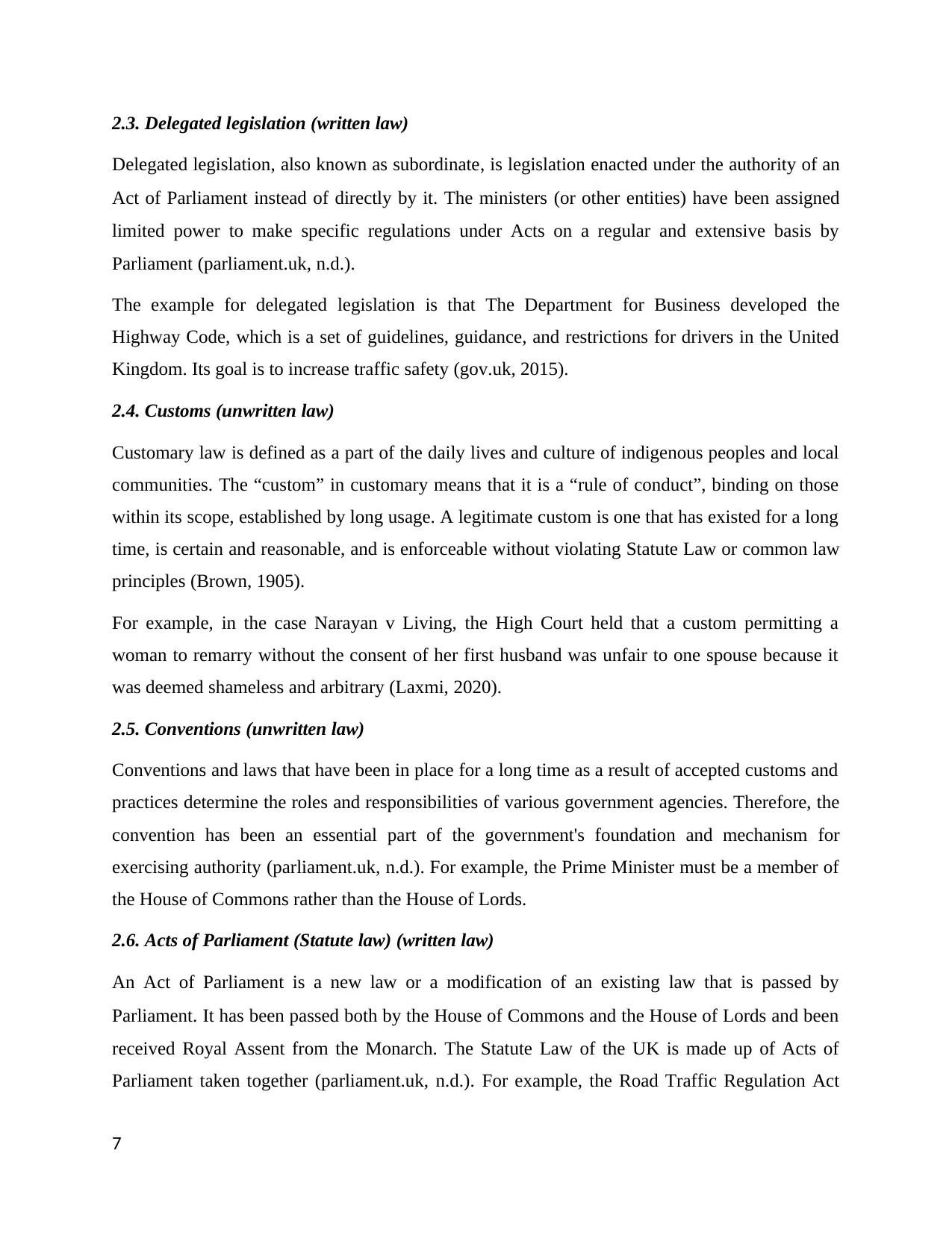
2.3. Delegated legislation (written law)
Delegated legislation, also known as subordinate, is legislation enacted under the authority of an
Act of Parliament instead of directly by it. The ministers (or other entities) have been assigned
limited power to make specific regulations under Acts on a regular and extensive basis by
Parliament (parliament.uk, n.d.).
The example for delegated legislation is that The Department for Business developed the
Highway Code, which is a set of guidelines, guidance, and restrictions for drivers in the United
Kingdom. Its goal is to increase traffic safety (gov.uk, 2015).
2.4. Customs (unwritten law)
Customary law is defined as a part of the daily lives and culture of indigenous peoples and local
communities. The “custom” in customary means that it is a “rule of conduct”, binding on those
within its scope, established by long usage. A legitimate custom is one that has existed for a long
time, is certain and reasonable, and is enforceable without violating Statute Law or common law
principles (Brown, 1905).
For example, in the case Narayan v Living, the High Court held that a custom permitting a
woman to remarry without the consent of her first husband was unfair to one spouse because it
was deemed shameless and arbitrary (Laxmi, 2020).
2.5. Conventions (unwritten law)
Conventions and laws that have been in place for a long time as a result of accepted customs and
practices determine the roles and responsibilities of various government agencies. Therefore, the
convention has been an essential part of the government's foundation and mechanism for
exercising authority (parliament.uk, n.d.). For example, the Prime Minister must be a member of
the House of Commons rather than the House of Lords.
2.6. Acts of Parliament (Statute law) (written law)
An Act of Parliament is a new law or a modification of an existing law that is passed by
Parliament. It has been passed both by the House of Commons and the House of Lords and been
received Royal Assent from the Monarch. The Statute Law of the UK is made up of Acts of
Parliament taken together (parliament.uk, n.d.). For example, the Road Traffic Regulation Act
7
Delegated legislation, also known as subordinate, is legislation enacted under the authority of an
Act of Parliament instead of directly by it. The ministers (or other entities) have been assigned
limited power to make specific regulations under Acts on a regular and extensive basis by
Parliament (parliament.uk, n.d.).
The example for delegated legislation is that The Department for Business developed the
Highway Code, which is a set of guidelines, guidance, and restrictions for drivers in the United
Kingdom. Its goal is to increase traffic safety (gov.uk, 2015).
2.4. Customs (unwritten law)
Customary law is defined as a part of the daily lives and culture of indigenous peoples and local
communities. The “custom” in customary means that it is a “rule of conduct”, binding on those
within its scope, established by long usage. A legitimate custom is one that has existed for a long
time, is certain and reasonable, and is enforceable without violating Statute Law or common law
principles (Brown, 1905).
For example, in the case Narayan v Living, the High Court held that a custom permitting a
woman to remarry without the consent of her first husband was unfair to one spouse because it
was deemed shameless and arbitrary (Laxmi, 2020).
2.5. Conventions (unwritten law)
Conventions and laws that have been in place for a long time as a result of accepted customs and
practices determine the roles and responsibilities of various government agencies. Therefore, the
convention has been an essential part of the government's foundation and mechanism for
exercising authority (parliament.uk, n.d.). For example, the Prime Minister must be a member of
the House of Commons rather than the House of Lords.
2.6. Acts of Parliament (Statute law) (written law)
An Act of Parliament is a new law or a modification of an existing law that is passed by
Parliament. It has been passed both by the House of Commons and the House of Lords and been
received Royal Assent from the Monarch. The Statute Law of the UK is made up of Acts of
Parliament taken together (parliament.uk, n.d.). For example, the Road Traffic Regulation Act
7
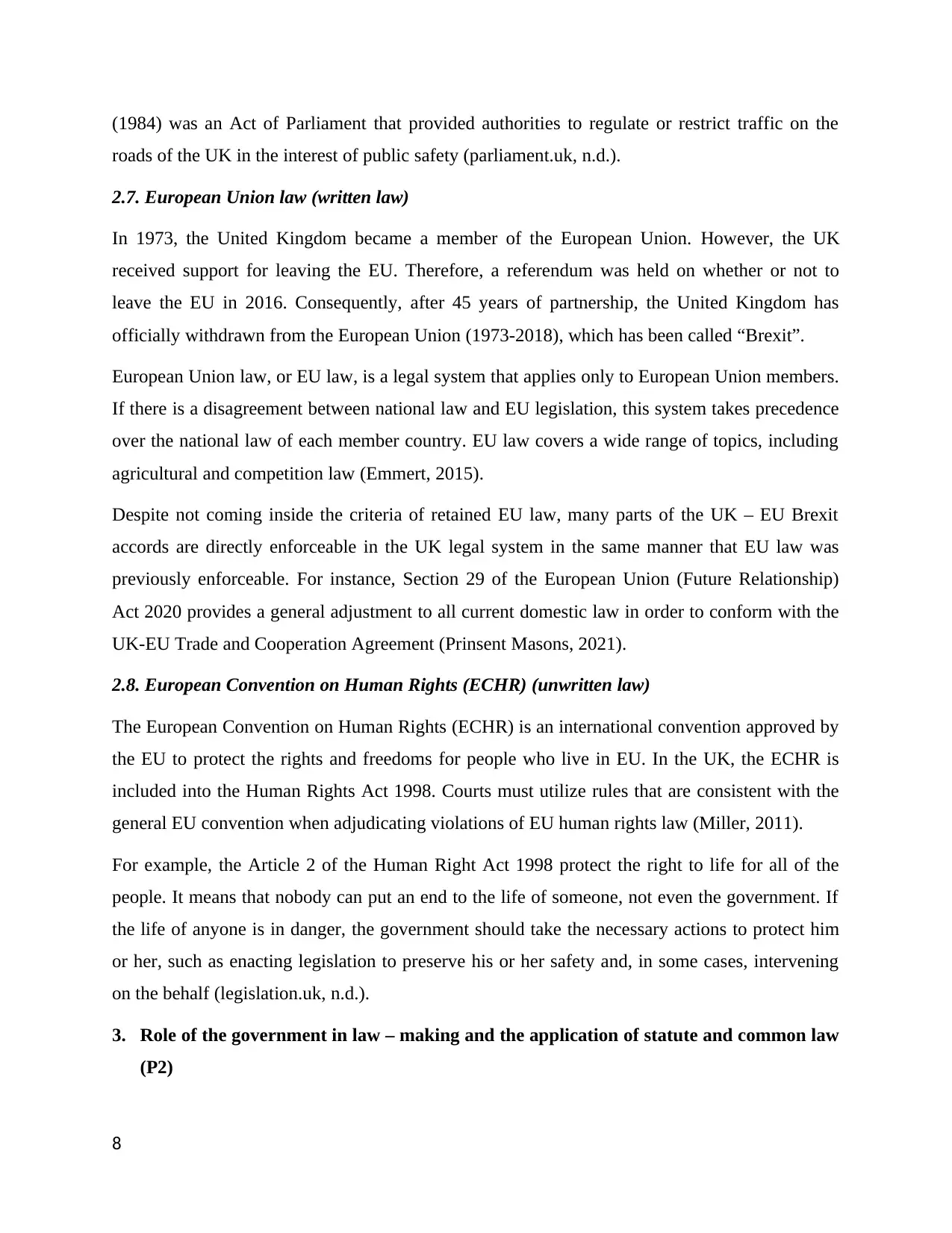
(1984) was an Act of Parliament that provided authorities to regulate or restrict traffic on the
roads of the UK in the interest of public safety (parliament.uk, n.d.).
2.7. European Union law (written law)
In 1973, the United Kingdom became a member of the European Union. However, the UK
received support for leaving the EU. Therefore, a referendum was held on whether or not to
leave the EU in 2016. Consequently, after 45 years of partnership, the United Kingdom has
officially withdrawn from the European Union (1973-2018), which has been called “Brexit”.
European Union law, or EU law, is a legal system that applies only to European Union members.
If there is a disagreement between national law and EU legislation, this system takes precedence
over the national law of each member country. EU law covers a wide range of topics, including
agricultural and competition law (Emmert, 2015).
Despite not coming inside the criteria of retained EU law, many parts of the UK – EU Brexit
accords are directly enforceable in the UK legal system in the same manner that EU law was
previously enforceable. For instance, Section 29 of the European Union (Future Relationship)
Act 2020 provides a general adjustment to all current domestic law in order to conform with the
UK-EU Trade and Cooperation Agreement (Prinsent Masons, 2021).
2.8. European Convention on Human Rights (ECHR) (unwritten law)
The European Convention on Human Rights (ECHR) is an international convention approved by
the EU to protect the rights and freedoms for people who live in EU. In the UK, the ECHR is
included into the Human Rights Act 1998. Courts must utilize rules that are consistent with the
general EU convention when adjudicating violations of EU human rights law (Miller, 2011).
For example, the Article 2 of the Human Right Act 1998 protect the right to life for all of the
people. It means that nobody can put an end to the life of someone, not even the government. If
the life of anyone is in danger, the government should take the necessary actions to protect him
or her, such as enacting legislation to preserve his or her safety and, in some cases, intervening
on the behalf (legislation.uk, n.d.).
3. Role of the government in law – making and the application of statute and common law
(P2)
8
roads of the UK in the interest of public safety (parliament.uk, n.d.).
2.7. European Union law (written law)
In 1973, the United Kingdom became a member of the European Union. However, the UK
received support for leaving the EU. Therefore, a referendum was held on whether or not to
leave the EU in 2016. Consequently, after 45 years of partnership, the United Kingdom has
officially withdrawn from the European Union (1973-2018), which has been called “Brexit”.
European Union law, or EU law, is a legal system that applies only to European Union members.
If there is a disagreement between national law and EU legislation, this system takes precedence
over the national law of each member country. EU law covers a wide range of topics, including
agricultural and competition law (Emmert, 2015).
Despite not coming inside the criteria of retained EU law, many parts of the UK – EU Brexit
accords are directly enforceable in the UK legal system in the same manner that EU law was
previously enforceable. For instance, Section 29 of the European Union (Future Relationship)
Act 2020 provides a general adjustment to all current domestic law in order to conform with the
UK-EU Trade and Cooperation Agreement (Prinsent Masons, 2021).
2.8. European Convention on Human Rights (ECHR) (unwritten law)
The European Convention on Human Rights (ECHR) is an international convention approved by
the EU to protect the rights and freedoms for people who live in EU. In the UK, the ECHR is
included into the Human Rights Act 1998. Courts must utilize rules that are consistent with the
general EU convention when adjudicating violations of EU human rights law (Miller, 2011).
For example, the Article 2 of the Human Right Act 1998 protect the right to life for all of the
people. It means that nobody can put an end to the life of someone, not even the government. If
the life of anyone is in danger, the government should take the necessary actions to protect him
or her, such as enacting legislation to preserve his or her safety and, in some cases, intervening
on the behalf (legislation.uk, n.d.).
3. Role of the government in law – making and the application of statute and common law
(P2)
8
⊘ This is a preview!⊘
Do you want full access?
Subscribe today to unlock all pages.

Trusted by 1+ million students worldwide
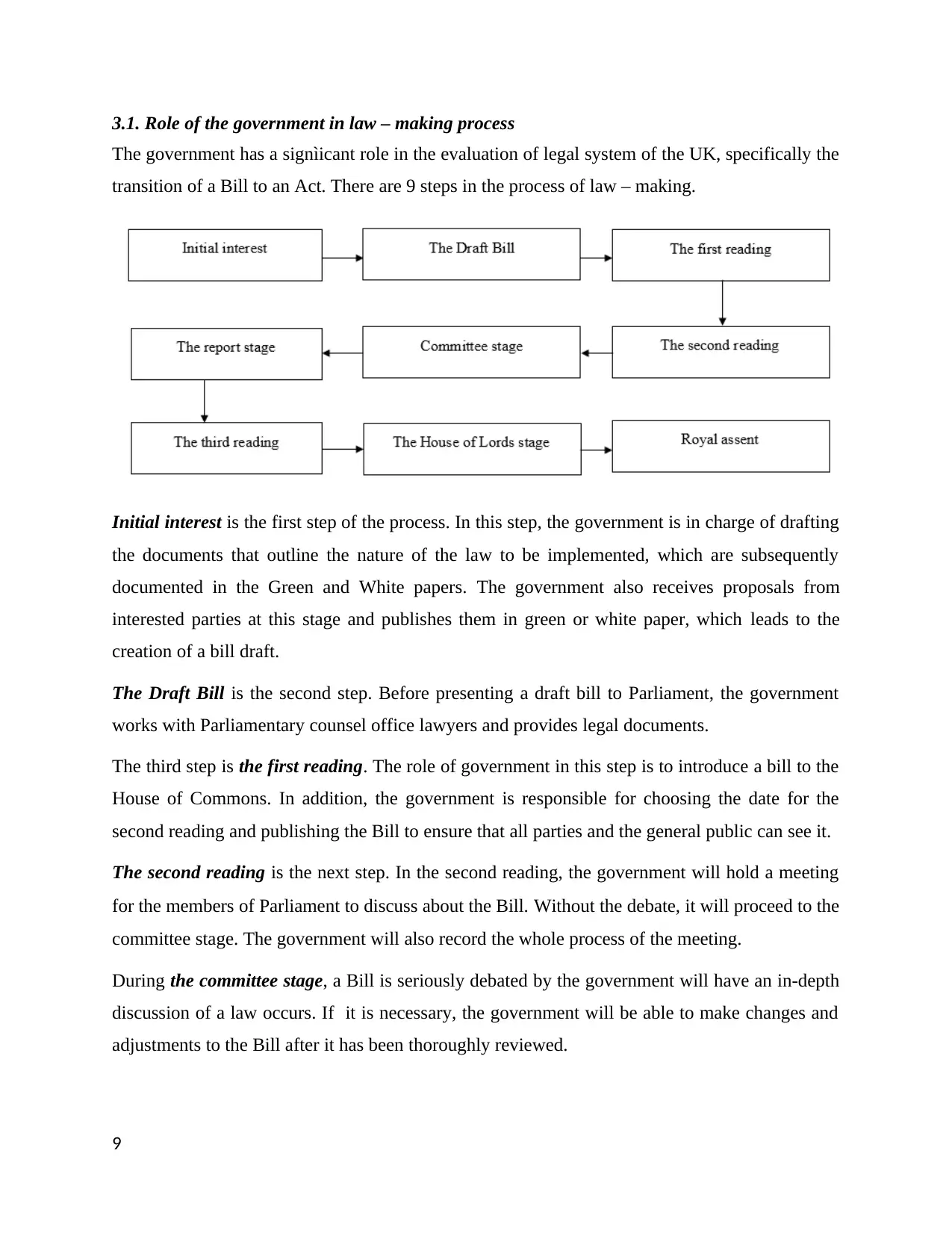
3.1. Role of the government in law – making process
The government has a signìicant role in the evaluation of legal system of the UK, specifically the
transition of a Bill to an Act. There are 9 steps in the process of law – making.
Initial interest is the first step of the process. In this step, the government is in charge of drafting
the documents that outline the nature of the law to be implemented, which are subsequently
documented in the Green and White papers. The government also receives proposals from
interested parties at this stage and publishes them in green or white paper, which leads to the
creation of a bill draft.
The Draft Bill is the second step. Before presenting a draft bill to Parliament, the government
works with Parliamentary counsel office lawyers and provides legal documents.
The third step is the first reading. The role of government in this step is to introduce a bill to the
House of Commons. In addition, the government is responsible for choosing the date for the
second reading and publishing the Bill to ensure that all parties and the general public can see it.
The second reading is the next step. In the second reading, the government will hold a meeting
for the members of Parliament to discuss about the Bill. Without the debate, it will proceed to the
committee stage. The government will also record the whole process of the meeting.
During the committee stage, a Bill is seriously debated by the government will have an in-depth
discussion of a law occurs. If it is necessary, the government will be able to make changes and
adjustments to the Bill after it has been thoroughly reviewed.
9
The government has a signìicant role in the evaluation of legal system of the UK, specifically the
transition of a Bill to an Act. There are 9 steps in the process of law – making.
Initial interest is the first step of the process. In this step, the government is in charge of drafting
the documents that outline the nature of the law to be implemented, which are subsequently
documented in the Green and White papers. The government also receives proposals from
interested parties at this stage and publishes them in green or white paper, which leads to the
creation of a bill draft.
The Draft Bill is the second step. Before presenting a draft bill to Parliament, the government
works with Parliamentary counsel office lawyers and provides legal documents.
The third step is the first reading. The role of government in this step is to introduce a bill to the
House of Commons. In addition, the government is responsible for choosing the date for the
second reading and publishing the Bill to ensure that all parties and the general public can see it.
The second reading is the next step. In the second reading, the government will hold a meeting
for the members of Parliament to discuss about the Bill. Without the debate, it will proceed to the
committee stage. The government will also record the whole process of the meeting.
During the committee stage, a Bill is seriously debated by the government will have an in-depth
discussion of a law occurs. If it is necessary, the government will be able to make changes and
adjustments to the Bill after it has been thoroughly reviewed.
9
Paraphrase This Document
Need a fresh take? Get an instant paraphrase of this document with our AI Paraphraser

In the report stage, the government is guilty of presenting drafts to the House of Commons for
consideration about additional amendments.
Next is the third reading. In this step, the government will convene a meeting for Members of
Parliament to allow them one more chance to vote, amend the document before sending it to the
House of Lords.
In the House of Lords stage, the government presents a draft bill to the House of Lords for
assessment and amendment. The government must announce any changes made by the Lord and
offer them to the House of Commons for reconciliation. On the contrary, if both the House of
Commons and the House of Lords agree on the amendments, they will be presented to the Queen
for ratification.
The royal assent is the final stage. After being approved by the Queen, the Bill will become law.
The government has a responsibility for publishing the law with all of the inhabitant living in the
country.
3.2. Application of Statutory and Common law Statutory law
Definition: In all cases, statutory law prevails over common law because it made by the
Parliament of the UK. All Acts begin as bills in the House of Commons or the House of Lords.
An Act is created when both Houses of Parliament agree on a bill and the Monarch grants it his
Royal Assent. Courts often apply strict interpretation to statutory legislation, which implies that
they are unable to read between the lines of a statute in order to liberalize its application, which
means that they will be bound by the terms of the agreement (parliament.uk, n.d.).
The application of statutory law:
- Act: The Road Trafic Act (1930)
- An example of a judge's decision
In the Elliot v Grey [1960] case, the car of the defendant was parked on the road but it was
removed the battery and jacked up. Therefore, he was charged with driving an uninsured vehicle
on the road under the Road Trafic Act (1930). The defendant claimed that because the car was
not driveable and he did not use it anymore. However, the court used the mischief rule to
determine that the car was being driven on the road because it represented a danger, and
10
consideration about additional amendments.
Next is the third reading. In this step, the government will convene a meeting for Members of
Parliament to allow them one more chance to vote, amend the document before sending it to the
House of Lords.
In the House of Lords stage, the government presents a draft bill to the House of Lords for
assessment and amendment. The government must announce any changes made by the Lord and
offer them to the House of Commons for reconciliation. On the contrary, if both the House of
Commons and the House of Lords agree on the amendments, they will be presented to the Queen
for ratification.
The royal assent is the final stage. After being approved by the Queen, the Bill will become law.
The government has a responsibility for publishing the law with all of the inhabitant living in the
country.
3.2. Application of Statutory and Common law Statutory law
Definition: In all cases, statutory law prevails over common law because it made by the
Parliament of the UK. All Acts begin as bills in the House of Commons or the House of Lords.
An Act is created when both Houses of Parliament agree on a bill and the Monarch grants it his
Royal Assent. Courts often apply strict interpretation to statutory legislation, which implies that
they are unable to read between the lines of a statute in order to liberalize its application, which
means that they will be bound by the terms of the agreement (parliament.uk, n.d.).
The application of statutory law:
- Act: The Road Trafic Act (1930)
- An example of a judge's decision
In the Elliot v Grey [1960] case, the car of the defendant was parked on the road but it was
removed the battery and jacked up. Therefore, he was charged with driving an uninsured vehicle
on the road under the Road Trafic Act (1930). The defendant claimed that because the car was
not driveable and he did not use it anymore. However, the court used the mischief rule to
determine that the car was being driven on the road because it represented a danger, and
10
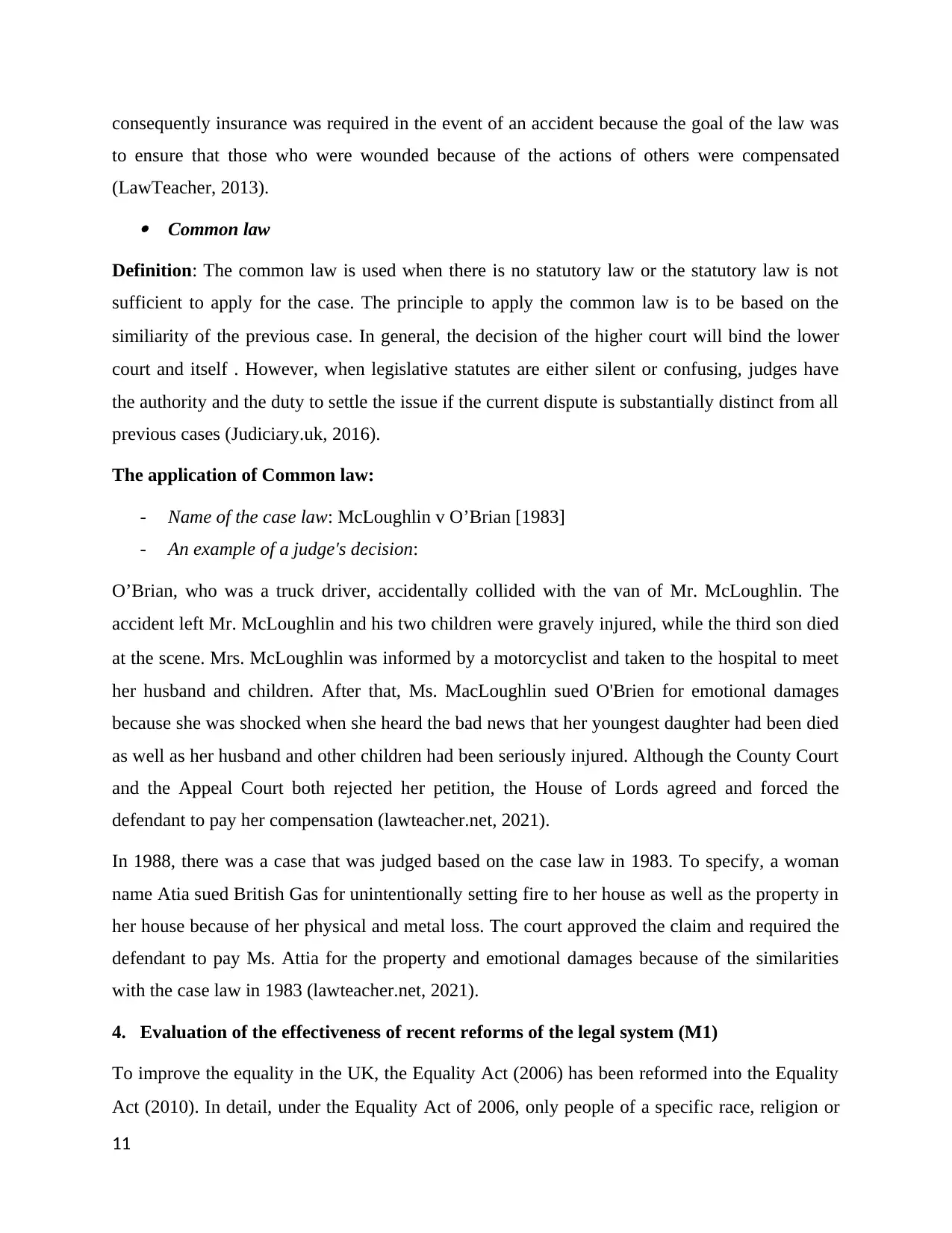
consequently insurance was required in the event of an accident because the goal of the law was
to ensure that those who were wounded because of the actions of others were compensated
(LawTeacher, 2013). Common law
Definition: The common law is used when there is no statutory law or the statutory law is not
sufficient to apply for the case. The principle to apply the common law is to be based on the
similiarity of the previous case. In general, the decision of the higher court will bind the lower
court and itself . However, when legislative statutes are either silent or confusing, judges have
the authority and the duty to settle the issue if the current dispute is substantially distinct from all
previous cases (Judiciary.uk, 2016).
The application of Common law:
- Name of the case law: McLoughlin v O’Brian [1983]
- An example of a judge's decision:
O’Brian, who was a truck driver, accidentally collided with the van of Mr. McLoughlin. The
accident left Mr. McLoughlin and his two children were gravely injured, while the third son died
at the scene. Mrs. McLoughlin was informed by a motorcyclist and taken to the hospital to meet
her husband and children. After that, Ms. MacLoughlin sued O'Brien for emotional damages
because she was shocked when she heard the bad news that her youngest daughter had been died
as well as her husband and other children had been seriously injured. Although the County Court
and the Appeal Court both rejected her petition, the House of Lords agreed and forced the
defendant to pay her compensation (lawteacher.net, 2021).
In 1988, there was a case that was judged based on the case law in 1983. To specify, a woman
name Atia sued British Gas for unintentionally setting fire to her house as well as the property in
her house because of her physical and metal loss. The court approved the claim and required the
defendant to pay Ms. Attia for the property and emotional damages because of the similarities
with the case law in 1983 (lawteacher.net, 2021).
4. Evaluation of the effectiveness of recent reforms of the legal system (M1)
To improve the equality in the UK, the Equality Act (2006) has been reformed into the Equality
Act (2010). In detail, under the Equality Act of 2006, only people of a specific race, religion or
11
to ensure that those who were wounded because of the actions of others were compensated
(LawTeacher, 2013). Common law
Definition: The common law is used when there is no statutory law or the statutory law is not
sufficient to apply for the case. The principle to apply the common law is to be based on the
similiarity of the previous case. In general, the decision of the higher court will bind the lower
court and itself . However, when legislative statutes are either silent or confusing, judges have
the authority and the duty to settle the issue if the current dispute is substantially distinct from all
previous cases (Judiciary.uk, 2016).
The application of Common law:
- Name of the case law: McLoughlin v O’Brian [1983]
- An example of a judge's decision:
O’Brian, who was a truck driver, accidentally collided with the van of Mr. McLoughlin. The
accident left Mr. McLoughlin and his two children were gravely injured, while the third son died
at the scene. Mrs. McLoughlin was informed by a motorcyclist and taken to the hospital to meet
her husband and children. After that, Ms. MacLoughlin sued O'Brien for emotional damages
because she was shocked when she heard the bad news that her youngest daughter had been died
as well as her husband and other children had been seriously injured. Although the County Court
and the Appeal Court both rejected her petition, the House of Lords agreed and forced the
defendant to pay her compensation (lawteacher.net, 2021).
In 1988, there was a case that was judged based on the case law in 1983. To specify, a woman
name Atia sued British Gas for unintentionally setting fire to her house as well as the property in
her house because of her physical and metal loss. The court approved the claim and required the
defendant to pay Ms. Attia for the property and emotional damages because of the similarities
with the case law in 1983 (lawteacher.net, 2021).
4. Evaluation of the effectiveness of recent reforms of the legal system (M1)
To improve the equality in the UK, the Equality Act (2006) has been reformed into the Equality
Act (2010). In detail, under the Equality Act of 2006, only people of a specific race, religion or
11
⊘ This is a preview!⊘
Do you want full access?
Subscribe today to unlock all pages.

Trusted by 1+ million students worldwide
1 out of 25
Related Documents
Your All-in-One AI-Powered Toolkit for Academic Success.
+13062052269
info@desklib.com
Available 24*7 on WhatsApp / Email
![[object Object]](/_next/static/media/star-bottom.7253800d.svg)
Unlock your academic potential
Copyright © 2020–2025 A2Z Services. All Rights Reserved. Developed and managed by ZUCOL.





